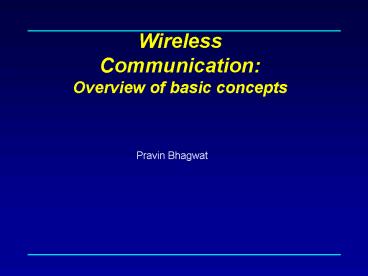Wireless Communication: Overview of basic concepts - PowerPoint PPT Presentation
1 / 11
Title:
Wireless Communication: Overview of basic concepts
Description:
No interference. High interference. noise; co-channel ... Signal propagation mechanisms. Path loss. Fading. Inter-Symbol Interference. Meaning of S/N ratio ... – PowerPoint PPT presentation
Number of Views:965
Avg rating:3.0/5.0
Title: Wireless Communication: Overview of basic concepts
1
Wireless Communication Overview of basic
concepts
- Pravin Bhagwat
2
Wired Vs. Wireless Communication
Each cable is a different channel
One media (cable) shared by all
High signal attenuation
Signal attenuation is low
High interference noise co-channel interference
adjacent channel interference
No interference
3
Why go wireless ?
- Advantages
- Sometimes it is impractical to lay cables
- User mobility
- Cost
- Limitations
- Bandwidth
- Fidelity
- Power
- (In)security
4
EM Spectrum
X rays
Gamma rays
visible
UV
infrared
?
1 MHz
1 kHz
1 GHz
1 THz
1 PHz
1 EHz
Propagation characteristics are different in each
frequency band
5
Unlicensed Radio Spectrum
?
12cm
5cm
33cm
26 Mhz
83.5 Mhz
125 Mhz
902 Mhz
2.4 Ghz
5.725 Ghz
2.4835 Ghz
5.850 Ghz
928 Mhz
802.11 Bluetooth Microwave oven
unused
cordless phones baby monitors Wireless LANs
6
Understanding wireless communication
Tx
Rx
- How does signal propagate ?
- How much attenuation take place ?
- How does signal look like at the receiver ?
7
Radio Propagation
Three basic propagation mechanisms
Scattering ? gtgt D
Diffraction ? ? D
Reflection ? ltlt D
- At 2.4 Ghz, leaves, lamp-posts can cause
scattering
8
dB (relative measure)
dB 10 log (times)
10,000 times
10,000 1,000 times 10,000,000 times
40 dB
40 dB 30 dB 70dB
1,000 times
30 dB
9
Path loss in dB
Path loss from source to d2 70dB
10
dBm ( absolute measure of power)
40 dBm
10,000 times
0 dBm
- 1,000 times
-30 dBm
11
Summary
- Difference between wired and wireless media
- Advantages of wireless communication
- Terms spectrum, bandwidth
- Three concepts
- Signal propagation mechanisms
- Path loss
- Fading
- Inter-Symbol Interference
- Meaning of S/N ratio































